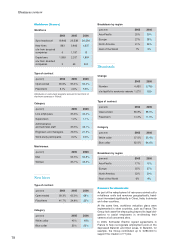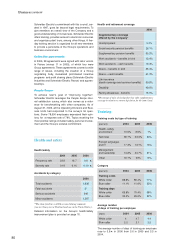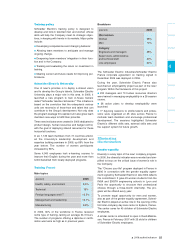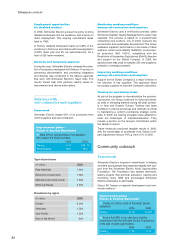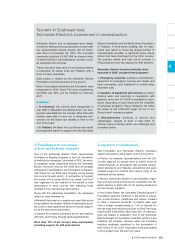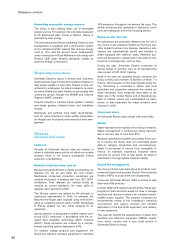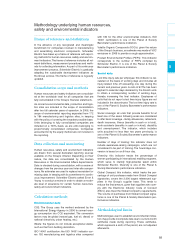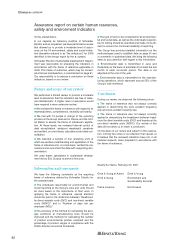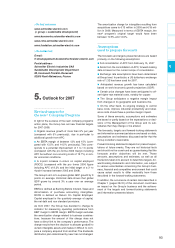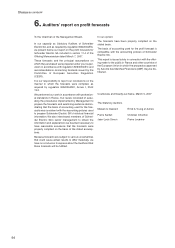APC 2006 Annual Report Download - page 87
Download and view the complete annual report
Please find page 87 of the 2006 APC annual report below. You can navigate through the pages in the report by either clicking on the pages listed below, or by using the keyword search tool below to find specific information within the annual report.
85
4
Examples
In Spain, the city of Meliana’s business development
council asked Schneider Electric to participate in a
pilot project to encourage the hiring of disadvantaged
individuals, including foreigners, single parents, vic-
tims of domestic violence and people with disabilities.
The program attracted some 200 participants. Half of
those who received training were hired to work on
assembly lines at Schneider Electric’s local site.
In France, the national government launched a cam-
paign called "100 opportunities – 100 jobs" with the
city of Grenoble and Schneider Electric in January
2006. The campaign targets low-skilled residents of
depressed neighborhoods, aged 18 to 30, who are
motivated and ready to take part in a job opportunity
program.The objective is to open the door to long-term
employment within a period of 36 months by offering
personalized skills-qualification paths with the help of
30 companies brought together and led by Schneider
Electric. A positive outcome target of 60% has been
set, meaning that participants obtain a fixed-term con-
tract of more than six months, an open-ended contract
or a skills-qualification training contract. The first "100
opportunities – 100 jobs" campaign was held in Janu-
ary 2005 in Chalon sur Saône, in partnership with
Schneider Electric subsidiary SFG. A similar campaign
is planned in 2007 in Normandy.
Business creation
Over the past ten years, Schneider Electric has sup-
ported employee projects in France to create busi-
nesses or buy going concerns through Schneider Ini-
tiatives Emploi (SIE)–a dedicated structure that allows
the Group to address its employment and regional
development responsibilities. The association provides
confidential support during all stages of business cre-
ation, as well as afterwards, with a minimum follow-up
period of three years. More than 500 project sponsors
have gone on to head their own businesses in a vari-
ety of professions, from baker to consultant to electri-
cian. SIE-backed projects show a success rate of 85%
over three years. On average, each project creates
1.95 jobs.
A directory of 350 participants was widely circulated
throughout the Company in 2006, as well as among
the program’s alumni.
Innovation
To prepare the solutions of the future, Schneider Elec-
tric devotes nearly 5% of its revenue to R&D. In 2005,
the Group set up a scientific council to provide guid-
ance on the ongoing evolution of science, technology
and innovation. In particular, the council is responsible
for understanding the Group’s approaches and making
recommendations in the following areas:
Scientific and technical policy governing products,
product development, manufacturing, services, etc.,
notably as concerns emerging technologies and/or
technologies from other industries that could have an
impact on Schneider Electric’s businesses.
ISO 14001 certification
Total
Dec. 31, 2005 174
Target for end-2006 38
New certifications at end-2006 18
Dec. 31, 2006 192*
* Including site closures and consolidation in 2006.
Research and innovation program management
(innovation practices, scientific and technical coopera-
tion, patent strategy, international deployment, cus-
tomer involvement, suppliers, etc.).
The Group’s global competencies strategy.
Increasingly, Schneider Electric is focusing its research
on such topics as energy efficiency, speed drives,
energy metering and lighting management. In medi-
um voltage, it is doing work on new sensors and soft-
ware to give devices advanced diagnostic functions.
Group teams are also designing new electrical distri-
bution products to feed energy from solar power,
micro-turbines, wind farms or fuel cells into the power
grid.
(See "Worldclass R&D", page 25).
Environmental
performance
Schneider Electric fully assumes its environmental
responsibility at all levels of the business by participat-
ing in the definition of new regulations and applying
them early, by making sites more energy efficient, by
promoting eco-design, and by raising employees’ and
partners’ environmental awareness.
Framework
Schneider Electric neither generates nor distributes
electricity. Its business primarily relies on assembly
and monitoring techniques and includes very few
processes with a more significant environmental
impact, such as metal processing and treatment.
The Group has 205 manufacturing facilities.
It is committed to including all units in the scope of
reporting. In 2005, environmental reporting was expand-
ed from manufacturing sits to logistics facilities. The
number of units covered grew to 184 in 2006 from 172
in 2005 and 139 in 2003, despite site closures and
consolidation during the year.
The environmental reporting principles were officially
audited in early 2006 and in early 2007.
In 2006, the Group implemented a process to measure
CO2 emissions from primary energy consumption and
to estimate volatile organic compound emissions. The
data will be published for the first time in 2007.
2006 audited indicators





